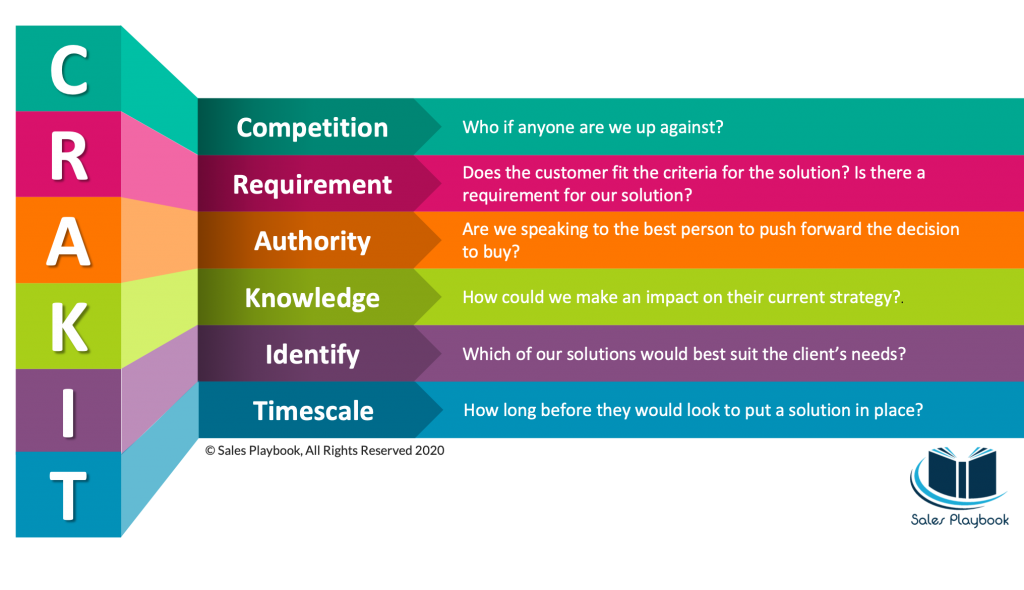
The qualification stage of a sales pipeline is where a sales rep will typically spend most of their time. Qualification starts at the prospecting step and continues through to discovery in the sales process. It’s important to gather as much information around the buyer’s situation, challenges and motivations and is worth spending the time and being patient. But, first you want to make sure the lead is suitable for your organisation to proceed so that time is not wasted, and this will begin at the contact stage of a sales pipeline.
The key when contacting potential buyers is to qualify the lead to ascertain which buyers meet a specific criteria to move forward to full qualification. You want the sales reps to spend their time on leads that have the best possible chance to convert into a sale. An example would be if the buyer’s timeline for a purchase is 2 years, but another buyer’s timeline is 6 months, most of a reps’ time will be spent with the latter, while the buyer with a 2 year window will be continually nurtured until the timing is closer.
Depending on the size and structure of an organisation, the prospecting may be actioned by an SDR (Sales Development Representative) or BDR (Business Development Representative). If this is the case, they will do the contact stage of the sales pipeline, then, once they have found specific information, they will move this to the qualification stage, where a sales rep will take over to action an in depth discovery. Other organisations will have sales reps complete all steps of the sales process including prospecting, but either way a qualification process in both prospecting and discovery should be mandatory in most businesses.
Laying out a set of qualification questions is paramount for the contact stage of a sales pipeline and using an acronym here can map out what elements a business wants to collect in order to know when to move a buyer through to discovery in the sales process. It is important that the qualification questions along with the acronym are included in your company’s Sales Playbook. There may be a number of suitable acronyms already available for initial qualification, but companies could choose to create their own so that this can be as relevant as possible to their organisation.
Lead Qualification Acronym
A qualification acronym is a great way to lay out what information is required when prospecting a potential customer, before moving them through to the discovery step in the sales process. This can have as many elements as required, but typically these will be between 4 to 6 letters.
If your organisation has a sales development or business development division that focus on lead generation for the sales team then having a qualification acronym gives them clear guidelines on what information to collect before the lead is passed across. This also prevents the sales reps suggesting that a lead is not suitable if everyone is aware and in agreement with the system in place. This also benefits senior leadership to see what is or what is not working and make changes accordingly.
This qualification acronym should be included in your Sales Playbook along with sample questions to ask in each element.
Let’s look at a few examples of qualification acronyms that could be used for the contact stage of a sales pipeline and the prospecting step of the sales process.
- BANT = Budget, Authority, Need, Timing
Created by IBM, BANT is a famous acronym and one that some companies have actually used as a sales methodology before these evolved. The four elements of BANT are used to ascertain if the client had the financial means to buy the product or service, if the person being spoken with was a decision maker, if their company had the need for this type of product or service and then finally how long it would be before the purchase could be made.
- FAINT = Funds, Authority, Interest, Need, Timing
The RAIN Group created FAINT, which is very similar to BANT but emphasizes that funds is not looking at a specific budget allocated for this purchase, but instead looking at whether the organisation has the financial capacity to spend if they found a solution that is worthwhile. They then look to the authority to generate interest from the buyer by showing what the product/service can achieve, before uncovering the specific need and finally establishing the timing.
- ANUM = Authority, Need, Urgency, Money
Developed in 2012, ANUM takes the principles of BANT but rearranges them in an order that puts the Authority at the front, the need as secondary with timescale (urgency) and then the money (budget) left to until the end. The main take from the ANUM acronym with Authority put first is that if you’re not speaking with the right person then you’re unlikely to sell anything. Whether this is true in our new age of sales is debatable.
- CHAMP = Challenges, Authority, Money, Prioritization
CHAMP very similar to ANUM takes the principles of BANT, but puts the emphasis on the challenges (need) of the buyer. By discussing the challenges and uncovering the need first you can ascertain immediately if there is a problem your solution can solve. The challenger criterion is also good because it’s buyer centric as opposed to seller focused.
Lead Qualification vs Sales Methodology
Whilst these acronyms are not suitable as a company’s complete sales methodology they should certainly be used to initially qualify a lead in a sales reps or development reps sales pipeline. Qualification acronyms can be the main driver for a company’s selling methodology, but a sales methodology is a philosophy on how to sell, so the acronym should really be left as a front end qualifying structure rather than a complete methodology along the lifetime of the sales process.
My article The Right Sales Methodology can provide further information.
The key criteria for choosing or creating a suitable qualification acronym is making it pronounceable, easy for sales to remember and relevant to the initial information a company requires to separate the prospects from the opportunities, thus making sure the time of the sales rep is spent on the leads with the highest likelihood to convert into a sale.
The Creation of the CRAKIT Acronym
I was working for a company and looking after a team of BDRs (Business Development Representatives). The company’s structure around their sales division wasn’t prepared to generate a good quality lead flow from the Business Development team. There was no acronym or guidance given for qualifying a lead.
However, putting a structure in place for the BDRs was my top priority. The first step to building an organised framework for the Business Development team was to introduce an acronym for qualifying their leads. After some thought I created CRAKIT (Competition, Requirement, Authority, Knowledge, Identify and Timescale). The idea around this acronym was that if all elements were successfully qualified, the sales reps would have a real opportunity and the BDRs had a structure around their prospecting activities. Once all the information had been collected they could say that they have ‘cracked it’, so there is an element of fun with this acronym as well. The CRAKIT breakdown is as follows:

This acronym is meaningful, memorable and could easily be implemented into a sales methodology. It stays away from the old style type, where budget is not asked for but brought in over time, during discovery. In the new age of selling were value is key, by staying away from discussing budget during a conversation, you are focusing on how you can make an impact, if your solution is best for the buyer and always investigating rather than potentially putting a prospect off by asking them if they have enough money to buy in the early stages!
Qualification Questions
Below are ten examples of questions that could be used during initial qualification. It’s important to ask open-ended questions, not to be pushy and aim the questions toward your industry and products or services while at the same time making it all about the prospect.
- How do you currently resolve issues around X, Y, Z?
- What has worked and what hasn´t with your current solution?
- What features/benefits would you ideally like to receive if you were to change to a different product/service?
- What features/benefits are a must have vs a nice to have?
- Why do you need these specific features/benefits?
- Which departments are involved in the use of this product/service?
- What are the top challenges your team is currently facing?
- When ideally would you like this product/service to be implemented for your team?
- How many obstacles do you see preventing this solution being implemented?
- How does next Tuesday suit you for our next meeting?
In conclusion…
The qualifying structure should not be misinterpreted as the series of questions that must be asked to a prospect from top to bottom, unless otherwise stated from your organisation. Instead these elements should be in place to help sales professionals gather specific information during conversations and to confirm that a potential buyer is not only the right fit, but is in the right time frame to move along the sales process. By asking the right questions and qualifying correctly you’ll have a strong continuous flow of ready to go opportunities in your sales pipeline and increase your chances of hitting target month on month.
“Be humble, be hungry, and always be the hardest worker in the room”
Thanks for reading. If you enjoyed this article please like below and share on your social channels.


